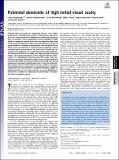Potential downside of high initial visual acuity
Author(s)
Vogelsang, Lukas; Gilad-Gutnick, Sharon; Ehrenberg, Evan; Yonas, Albert; Diamond, Sidney; Held, Richard M.; Sinha, Pawan; ... Show more Show less
DownloadPublished version (1.048Mb)
Terms of use
Metadata
Show full item recordAbstract
Children who are treated for congenital cataracts later exhibit impairments in configural face analysis. This has been explained in terms of a critical period for the acquisition of normal face processing. Here, we consider a more parsimonious account according to which deficits in configural analysis result from the abnormally high initial retinal acuity that children treated for cataracts experience, relative to typical newborns. According to this proposal, the initial period of low retinal acuity characteristic of normal visual development induces extended spatial processing in the cortex that is important for configural face judgments. As a computational test of this hypothesis, we examined the effects of training with high-resolution or blurred images, and staged combinations, on the receptive fields and performance of a convolutional neural network. The results show that commencing trainingwith blurred images creates receptive fields that integrate information across larger image areas and leads to improved performance and better generalization across a range of resolutions. These findings offer an explanation for the observed face recognition impairments after late treatment of congenital blindness, suggest an adaptive function for the acuity trajectory in normal development, and provide a scheme for improving the performance of computational face recognition systems. ©2018 National Academy of Sciences. All rights reserved.
Date issued
2018-10Department
Massachusetts Institute of Technology. Department of Brain and Cognitive SciencesJournal
Proceedings of the National Academy of Sciences of the United States of America
Publisher
Proceedings of the National Academy of Sciences
Citation
Vogelsang, Lukas et al., "Potential downside of high initial visual acuity." Proceedings of the National Academy of Sciences of the United States of America 115, 44 (October 2018): 11333-38 ©2018 Authors
Version: Final published version
ISSN
1091-6490